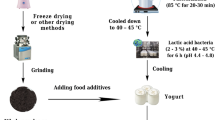Abstract
To evaluate the dietary protein utilization and iron deficiency anemia as affected by the faba bean nutrient intake, a bioassay with rats was carried out with different experimental diets containing four faba bean products (stewed beans ‘Medammis’, deep fried dough ‘Falafel’, boiled germinated beans ‘Nabet Soup’ and poured paste ‘Bissara’) widely consumed in the Middle East. Amino acid composition of all faba bean products was determined and compared to raw beans. Severe heat-processing markedly decreased some essential amino acids, especially phenylalanine, cystine, methionine and tryptophan. Protein scores were 24.6, 19.5, 29.2, 28.2 and 35.6 for raw faba beans, ‘Medammis’, ‘Falafel’, ‘Nabet Soup’ and ‘Bissara’, respectively. ‘Bissara’ possessed the highest nutritional value, since it had the lowest GDR value [Grams consumed of product to cover the daily requirements for adult man in protein (63 g) and in energy (2900 kcal)] for the limiting amino acids (L A A). As indicated by P S/150 values [Satisfaction of the daily requirements of the adult man when 150 g (one can content) are consumed of product] for L A A, i.e. methionine+cystine (lowest P S/150 value), the above-mentioned faba bean products cover about 53, 77, 77 and 97% of the daily requirements of adult man in L A A, respectively. Fecal nitrogen excretion increased and true nitrogen digestibility decreased significantly (p<0.01) with the inclusion of ‘Medammis’ in the diet. ‘Nabet Soup’ exhibited the highest true nitrogen digestibility. In contrast, the biological value of nitrogen was apparently unaffected. Highest blood hemoglobin level was found in rats fed diets containing ‘Bissara’, ‘Falafel’ and ‘Nabet Soup’, whereas the addition of ‘Medammis’ in the diet induced a significant (p<0.05) reduction in blood hemoglobin level of fed rats.
Similar content being viewed by others
References
Deshpande SS, Sathe SK, Salunkhe DK, Gornforth DP (1982) Effects of dehulling on phytic acid, polyphenols and enzyme inhibitors of dry beans (Phaseolus vulgaris L.) J Food Sci 47: 1846–1850.
Donoso G, Hedayant H, Khayation H (1969) Favism, with special reference to Iran. Bull World Health Organ 40: 513–519.
Martin-Tanguy J, Guillaume J, Kossa A (1977) Condensed tannins in horse bean seeds: Chemical structure and apparent effects on poultry. J Sci Food Agric 28: 757–765.
Whitney EN, Hamilton EMN, Rolfes SR (1990) Understanding nutrition, 5th edn. New York: West Publishing Company.
Bogunjoko FE, Neale RJ, Ledward DA (1983) Availability of iron from chicken meat and liver given to rats. Br J Nutrition 50: 511–520.
Shehab SK, Ghali NN, Ibrahim AA, Abdel Aal MS (1989) The prevalence of anemia among university female students in Cairo. Fourth Int Conf Stat Comp Demo Res Cairo, 25–30 March 1989, pp 291–300.
Youssef MM, Hamza MA, Abd El-Aal MH, Shekib LA, El-Banna AA (1986) Amino acid composition and in vitro digestibility of some Egyptian foods made from faba bean (Vicia faba L.). Food Chem 22: 225–233.
AOAC (1980). Official methods of analysis. Washington, DC: Association of Official Analytical Chemists.
Wheeler EI, Ferrel RE (1971) A method for phytic acid determination in wheat and wheat fractions. Cereal Chem 48: 312–315.
Moore S, Spachman DH, Steins W (1958) Chromatography of amino acids on sulphonated polystyrene resins. Anal Chem 30: 1185–1190.
Chavan JK, Heigaard J (1981) Detection and partial characterization of subtilisin inhibitors in legume seeds by isoelectric focusing. J Sci Food Agric 32: 857–859.
Ocio E (1963) Modification del valor biologieo de la caseina en ratas en crecimiento por el efecto de la suplementacion con methionina, arginina y glicina. Revista de Nutricion Animal 1: 126–185.
Alzueta C, Trevino J, Ortiz L (1992) Effect of tannins from faba beans on protein utilization in rats. J Sci Food Agric 59: 551–553.
Bauer J (1963) Composition and physiology of blood. In: Frankel S, Reitman S (eds), Clinical laboratory procedures and their interpretation, 6th edn. St Louis: Mosley.
Snedecor GW, Cochran WG (1967) Statistical methods. Iowa, USA: Iowa State University.
El-Mahdy AR (1974) Evaluation of Vicia faba beans as a source of protein and the influence of processing thereon. Ph D Thesis. Alexandria, Egypt: Faculty of Agriculture, University of Alexandria.
FAO (1982) Production year book. Rome: FAO.
Brassani R, Elias LG (1974) Legume foods. In: Altschul AH (ed), New protein foods. New York: Academic Press, pp. 230–297.
Sales MG, Weber C, Taylor RR, Stull JM (1984) Effect of mild alkali treatment or dry-roasting of cowpea (Vigna sinensis) on protein quality. Nutr Rep Int 29: 243–247.
Hamza MA (1983). Electrophoretic studies on seed proteins of some Egyptain and German legume seeds. Ph D Thesis. Alexandria, Egypt: Faculty of Agriculture, University of Alexandria.
Oh HJ, Hoff JE (1989) Effect of condensed grape tannins on in vitro digestion of proteins. Nutr Report Inter 34: 51–58.
Butler LG (1989) Effect of condensed tannins on animal nutrition. In: Hemingway RW, Karchesy JJ (eds). New York: Plenum Press, pp. 390–401.
Ahmed AE, Smilhard R, Ellis M (1991) Activities of enzymes of the pancreas and the lumen and mucosa of the small intestine in growing broiler cockerels fed on tannincontaining diets. Br J Nutr 65: 189–197.
Moseley G, Griffiths W (1979) Varietal variation in the antinutritive effects of field beans (Vicia faba) when fed to rats. J Sci Food Agric 30: 772–778.
Lacassagne L, Francesch M, Carre B, Melcion JP (1988) Utilization of tannin-containing and tannin-free faba beans (Vicia faba) by young chicks: Effects of pelleting feeds on energy protein and starch digestibility. Anim Food Sci Technol 20: 59–68.
Jamalian J (1978) Favism-inducing toxins in broad beans (Vicia faba): Determination of vicine content and investigation of other non-protein nitrogen compounds in different broad bean cultivars. J Sci Agr 29: 136–141.
Author information
Authors and Affiliations
Rights and permissions
About this article
Cite this article
Bakr, A.A., Bayomy, M.F.F. Effect of selected Egyptian cooking methods on faba bean nutritive value and dietary protein utilization 2: Ability of faba bean products to support hemoglobin response in rats. Plant Food Hum Nutr 50, 81–91 (1997). https://doi.org/10.1007/BF02436046
Received:
Accepted:
Issue Date:
DOI: https://doi.org/10.1007/BF02436046




